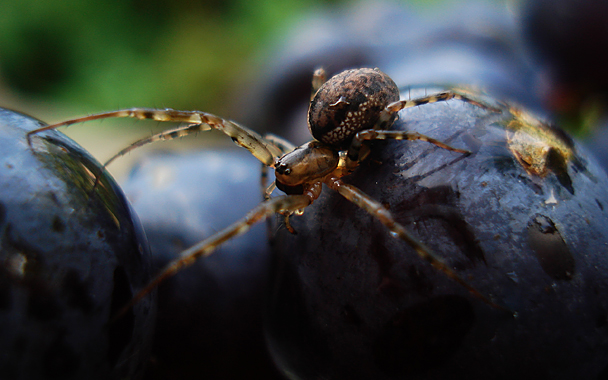The grapes on e-grocer Fresh Direct’s Web site come with this warning: “In an effort to reduce chemical pesticide use, many grape growers are now using spiders as a natural method to rid crops of insects. Occasionally, you may find a cobweb.” The slightly ominous implication: a spider might be attached.
Though it sounds like the stuff of urban legend, newspaper and TV reports of errant arachnids nestled in clusters of store-bought grapes have been confirmed in Ohio, Boston, South Africa, and the U.K. As the market for organic produce has grown over the last decade, so has reliance on natural predators like spiders, which have acted as a kind of biological pest control in rice paddies, fruit orchards, and corn and cotton fields for centuries. Without harming the grapes, spiders prey on the insects—aphids, caterpillars, leafhoppers—and mites in vineyards that hamper production. On the whole, the results of integrated pest management (IPM) are positive: Crop yields increase while chemical use decreases, resulting in better air, soil, and water quality. “IPM is very mainstream in the table-grape industry and has been for a while now,” Kathleen Nave, president of the California Table Grape Commission, says. “It’s just a smart, logical way to grow grapes, and spiders are a beneficial part of that.”
According to a study conducted by IPM experts at the University of California, Berkeley, spiders account for 95 percent of all vineyard predators, with some 10-50 spiders per vine. Of that number, however, an increasing percentage are black widows (highly venomous spiders whose bites can cause severe pain and, in very rare instances, death). And that’s where the trouble arises. As it turns out, black widows are relatively useless in IPM and are, in fact, considered to be pests themselves; few of their preferred prey pose a serious threat to grape yields, and the widows’ persistent and growing presence in vineyards makes them one of the most likely hijackers of store-bound fruit. The reason for the proliferation is two-fold: Not only do black widows thrive in organically farmed grape orchards where insects of all types abound, but they’re also thought to be resistant to many of the newer, less toxic insecticides and pesticides currently used by conventional growers.
The black widow is not the only spider to make its way from the vineyard to the produce aisle—or even the most dangerous. Earlier this month, what was initially thought to be a Brazilian wandering spider, the world’s deadliest arachnid, hitchhiked to a Tulsa, Oklahoma Whole Foods in a bunch of bananas. (It was found during a routine inspection, a Whole Foods manager said in a statement, and was later determined to be a different, and relatively harmless, species. Requests for comment weren’t answered by press time.) But the black widow poses a unique set of challenges. The approximately 550 farmers who make up California’s table-grape industry produce 98 percent of the fresh grapes grown in the U.S. In 2008, they transported more than 98.5 million boxes, or roughly 187 million pounds, of fresh grapes across the country and to more than 50 overseas markets. Even one black widow sighting can incite public fear and cripple international trade. In 2001, for instance, New Zealand banned imports of California table grapes after four spiders were found in a shipment. Today, Australia and New Zealand require gassing and inspection of all incoming table grapes to avoid bringing black widows into the country.
To boost consumer confidence and forestall a potential marketing nightmare, the table-grape industry has spent millions of dollars on grower education, better inspection protocols, and research into new control and eradication methods. “We’ve been dealing with the black widow issue since the 1990s,” Nave explains. “It’s a high-level concern that led growers to spend their own money to study the spider’s life cycle, what chemicals they’re most vulnerable to, where they live within the vineyard. One spider in the marketplace is too many.”
Still, as organic produce becomes more prevalent and the amount of chemical pesticides and insecticides on farms is reduced, it’s almost certain that more insects will show up on food—both in the fields and on the shelves. “Organic growers don’t have a lot of proven options for controlling spiders,” Dr. Devin Carroll, an IPM consultant who has spent more than 20 years observing spiders in vineyards, says. “Care during packing is important, but it’s hard to avoid missing a few.”



 Pinterest
Pinterest


